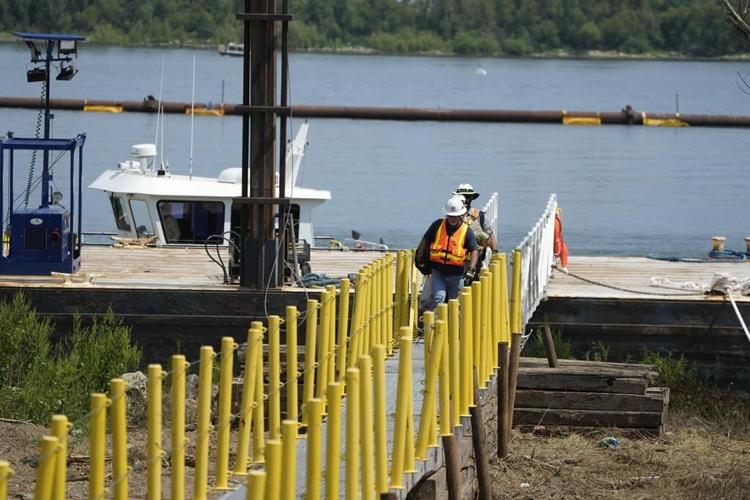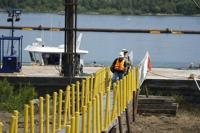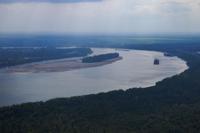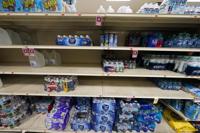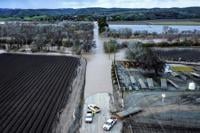BATON ROUGE, La. (AP) — For months, residents in the southeast corner of Louisiana have relied on bottled water for drinking and cooking, with the water from the faucet coming out salty.
Plaquemines Parish Councilman Mark “Hobbo” Cognevich, who represents the affected area, said grocery stores are constantly having to restock plastic water bottles, neighbors have reported getting rashes after showering, and, overall, the community is “fed up” with the situation.
“We are praying for rain,” Cognevich said. That is a sentiment echoed by officials across the state, as the drought-stricken Mississippi River’s flow is low and slow, allowing for salt water from the Gulf of Mexico to intrude upstream and threaten communities’ drinking supplies.
But with little precipitation in the forecast, officials are now hastily preparing for if and when the salt water will reach the state’s most populous city — New Orleans.
WHAT IS SALTWATER INTRUSION AND HOW DID IT HAPPEN?
Typically, the mighty flow of the Mississippi River — which stretches from northern Minnesota, through the center of the continental United States and out to the Gulf of Mexico — is enough to keep mass amounts of salt water from intruding too far upstream. But hot and dry conditions across the country this summer, triggering extreme drought, have affected the Mississippi. Officials expect the river volume to reach historic lows in the coming weeks.
Matt Roe, a spokesperson for the U.S. Army Corps of Engineers in New Orleans, said on Monday that when the flow of the river gets this weak, “it doesn’t have the mass and velocity needed to push the salt water back down around the mouth of the river.”
HOW IS THE SALT WATER AFFECTING LOUISIANA’S DRINKING WATER?
Many communities in south Louisiana rely on the Mississippi’s fresh water, with their water intake treatment facilities located along the river.
Unimpeded salt water continues to creep upriver and threatens municipal drinking water. That makes it unsafe to drink — especially for people with kidney disease, high blood pressure, people on a low-sodium diet, infants and pregnant women.
While most of the state still has fresh water flowing out of faucets, water advisories have been issued in parts of Plaquemines Parish since June. Edwards warns that other parishes may soon be affected by the salt water, including Orleans, St. Bernard and Jefferson. Although that likely won’t happen until mid-to-late October.
Edwards urged Louisianans not to panic or rush to buy bottled water. Instead, residents will be notified in advance if salt water will affect their area.
WHAT IS BEING DONE?
Officials are addressing the issue in multiple ways, including heightening an existing sill, an underwater levee used to block or slow the flow of salt water. Officials say the sill augmentation — which had been used during similar situations, in 1988, 2012 and last year — will delay salt water’s progression by about 10 to 15 days.
“We’re being proactive. We’re applying best practices and lessons learned from the past,” Edwards said.
In addition, millions of gallons of fresh water are being taken by barges to treatment facilities in impacted areas.
Edwards also plans to request an emergency declaration from the federal government to get more agencies to address the issue and authorize the state “to take emergency protective measures with some level of reimbursement available.”
But what is needed most right now is rain. And not just in Louisiana, but further north to strengthen the river’s flow,
WILL THE SALT WATER AFFECT OTHER THINGS?
The Mississippi is one of the world’s most important commercial waterways, and the Port of South Louisiana is critical for grain shipments, handling about 60% of U.S. grain exports.
Officials say they are doing what they can during the sill augmentation to keep the channel open to ships and barges.
However, traffic along the Mississippi is , which has left the river so low that barge companies are reducing their loads.
Additionally, state departments are monitoring the effects this could have on agriculture — specifically citrus nurseries, which rely heavily on irrigation and are more sensitive to salt water than a mature tree in the ground.
But with this likely being a long-duration event, the full effects of the saltwater intrusion have yet to be felt.

